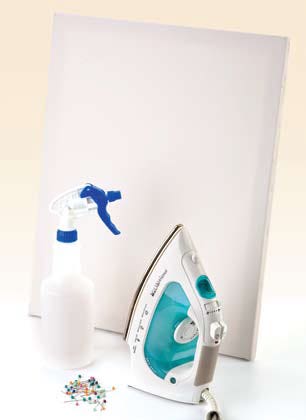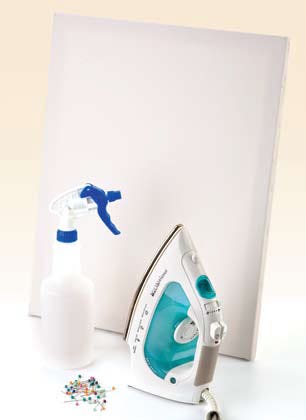How to Block a Finished Piece
Blocking your crochet items puts the finishing touch on your hours of stitching. While it isn’t many stitchers’ favorite part of the process, blocking truly enhances and beautifies your crochet projects. In this Annie’s special edition FREE video class, you’ll gain valuable information on
blocking techniques and materials used for both crochet and knit items. The helpful content in this class is a compilation of blocking instructions given in three Annie’s online classes: Crocheting With Thread with Susan Lowman, Knit Finishing Techniques with Carri Hammett and Lace & Openwork Knitting Workshop with Jill Wright. In this free class, you’ll learn:
- Why blocking is essential and how it changes the look of your projects.
- What supplies are needed for blocking.
- How to make an inexpensive and lightweight blocking board.
- How to block garments to the match schematic and fit your body.
- How to block doilies, filet crochet and lace.
- How to wet-block, steam-block and block with wires, pins and thread.
Take advantage of this free Annie's special edition online class, and learn how to successfully and beautifully block your crochet pieces. Blocking is an important step in making your crocheted pieces look more professional. It’s a way of “dressing,” or finishing, your projects using moisture and sometimes heat. Proper blocking of a crocheted garment or accessory can go a long way toward making it look and fit better, and it can help restore symmetrical balance to a misshapen afghan or rug. Blocking sets the stitches in place and can even enhance the drape of the fabric. Seaming and edging are easier to do with blocked pieces, and minor sizing adjustments can be made during the blocking process. There are different methods for blocking crocheted pieces, and knowing which one to use for a particular project can make a huge difference in the result. The correct blocking method depends on what the item is and what type of yarn or thread is being used. Some items might not be suitable for blocking, such as 3-D pieces that are difficult to handle or very small items such as Christmas ornaments. Also, certain fibers might not be suitable for blocking.


Getting Started
You’ll need a blocking board, rustproof pins, a steamer or steam iron, a spray bottle, and your yarn or thread labels. A blocking board is a flat surface that’s large enough to hold the piece or pieces you want to block. Pieces should not hang over the edges of the blocking board. If you don’t have, or can’t find, a commercially made blocking board, it’s easy to create your own. The free blocking video includes a detailed tutorial on how to make your own inexpensive blocking board. Purchase a piece of plastic foam insulation board at your local home-improvement center or a foam board from an office-supply store. When choosing the size of your board, keep in mind that while a larger board can block more pieces, it may be difficult to store. It might be better to purchase several smaller boards. Cover the board with a thick towel and then with a clean cotton cloth, both of which have been washed so that they will not bleed onto your work. Another option is to cover an ironing board or homemade blocking board with 1" checked gingham fabric for ease in pressing and blocking your needlework to the desired shape. You'll have great success in keeping your edges straight by lining it up with the 1" squares. Your blocking board will need to be in a location where it can remain undisturbed until the blocking is finished, which can range from just a few minutes to more than a day, depending on the circumstances. The board needs to be able to handle pins, moisture and heat. To block large items such as afghans or shawls, for example, a guest room bed or a large, well-padded table -- even a sheet-covered carpeted floor -- would work great.
Choosing Your Method
Blocking methods may be described as wet, dry or cold. The method you choose will vary depending on yarn content, intended use of the piece and your own preferences. Consult the yarn label. If different fibers have been combined in the same item, the most delicate fiber takes precedence. Most natural fibers such as wool, cotton, linen and mohair may be either wet- or dry-blocked. Some synthetic fibers do not benefit from blocking and may, in fact, be ruined by careless blocking. Novelty and metallic fibers may need special care and may not be suitable for blocking. While it’s always advisable to make a test swatch for any pattern to check gauge, an added benefit of making a swatch is that you will have a piece to practice blocking to make sure you are using the proper method. For example, did you know that too much heat can “kill” acrylic yarn, making it shiny and limp? It’s better to wreck a swatch than a whole afghan. Wet blocking is suitable only for fibers that can tolerate submersion. Wash the piece first, if desired, or thoroughly wet it and gently squeeze out excess water. Do not wring or twist. For 2-D pieces, lay the piece out flat, and gently pat and shape it to the desired finished measurements. Pin the piece securely in place using rustproof pins or blocking wires. For 3-D pieces, stuff the piece with rolled-up plastic grocery bags or other waterproof stuffing. For round pieces, blowing up a balloon to the desired size inside the item works well. Leave the piece undisturbed until it is completely dry. You can hasten the drying process by setting up a fan to blow over the area. Dry blocking is suitable for fibers that can tolerate moisture and heat (steam). Pin the piece to the desired shape and size on the blocking board. Pins should be close together and evenly spaced so as not to distort the fabric. Blocking wires also work well. Smooth all seams and areas that are puckered or rippled as much as possible with your fingers. Holding a steamer or steam iron an inch or more above the item, steam the fabric well. Move the iron slowly over the surface, never allowing it to touch the fabric; do not press. After steaming, leave the piece undisturbed until it is completely cool and dry. Cold blocking can be used for fibers that can tolerate moisture but not heat. Pin the piece into shape on the blocking board as you would for dry blocking. Mist with a spray bottle of clean water until the piece is completely wet. If stubborn areas resist lying flat, use additional pins as needed or press with your hand for a few seconds (it’s amazing how the gentle warmth from your skin can help!). Leave the item undisturbed until it is completely dry. Again, a fan can help speed things up.
Tips for Blocking Afghans & Other Large Pieces
Afghans and other large crochet pieces, such as tablecloths, bedspreads and shawls, can easily be blocked on a bed with a firm or extra-firm mattress, on a large, well-padded table, or on a clean, carpeted floor. Arrange the piece into a nice, even shape to the required or desired measurements, taking care not to overstretch or distort the shape of the piece. Using rustproof pins, pin all edges down securely around the entire piece. If any stubborn areas don’t want to lie down smoothly, adding a few extra pins in these spots usually does the trick. If desired, the piece can be dry-blocked as previously instructed. But, for large pieces such as these, you can also achieve beautiful results by blocking without the use of steam. Using a large spray bottle of chemical-free water, mist the piece thoroughly until it is lightly wet (semi-saturated). Use your hand to gently press each area as it is sprayed. It’s amazing how just the heat from your skin acts like a low-heat iron on wet yarn or thread, but without the possible damage to yarn fibers that an iron can cause. After the piece is thoroughly wet and hand-pressed, have a fan blow on the project until it’s completely dry. The results will be beautiful! Now that you know the different ways to block your projects and how to decide which to use, you’ll feel more confident to take that extra step and give your projects a more finished look for the results you desire. Still, don’t forget to practice on a test swatch first!
How to Block Projects Made With Acrylic Yarn
Iron/Steam:
Place your project flat on an ironing board. Then, set your steam iron to the “wool” setting and hover it over the cloth for a few minutes. Do not touch the iron to the fabric. Reshape your project, then lay flat to air-dry and cool completely. Remember that acrylic yarn will melt with heat, so it is important that you use caution
Blow-dryer:
This option is great because you don’t have to wait for the piece to dry. You have a piece of fabric ready to go almost immediately. Lay out your fabric and pin into the desired shape. Plug in the blow-dryer and turn it on to the high heat setting. You can use a lower heat setting if you’re afraid of melting the acrylic. Next, hover the blow-dryer a few inches above the fabric. Move back and forth across the fabric, making sure to focus on the edges. Do this for a couple of minutes. Press on the fabric to smooth out the edges. Turn off the blow-dryer and let the fabric cool before removing the pins.
Either of these options should work to block acrylic yarn. The blow-dryer option is slower, but has a lower chance of harming the yarn in the process.
